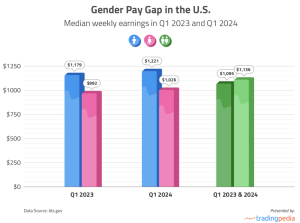Another year over, another year where women have continued to be paid less than men.
The persistence of gender-based pay inequality presents not only a social issue for US society but also a significant business challenge.
Our recent research highlights that, despite decades of effort, female employees and professionals still earn, on average, 15% less than their male counterparts.
While there has been improvement – the gender pay gap narrowed from 18% in 2017 to 15% in 2023 – the progress remains slow and inconsistent.

In managerial roles for instance, the gap has decreased from 14% to 10% over the same period, closing at a slightly faster rate. Yet, this pace remains insufficient, especially for mid- and late-career women managers, who have missed out on years of equitable pay and benefits despite holding equivalent roles to male colleagues.
All-told, the overall current sluggish rate of progress means that we project American women won’t reach a true “Equal Pay Day” until 2048.
What can be done
The good news is that CHROs can be at the forefront of implementing strategic steps to drive meaningful progress in pay equity.
We have identified ten effective actions they can take to accelerate change.
1) Putting pay equity on the map
Define a clear internal “why” for pay equity, by emphasizing its bottom-line business benefits, such as improved financial performance, customer satisfaction, and stronger talent attraction and retention.
Highlight the importance of fairness and compliance with legal standards, like the upcoming European Union Pay Transparency Directive.
Lastly, ensure that the pay equity initiative aligns with the company’s mission, vision, and values to foster broad internal support.
2) Assemble a pay equity team
Form a cross-functional team with broad organizational representation, including members from HR, legal, finance, and other key departments, to incorporate diverse perspectives and expertise into your pay equity efforts.
To ensure accountability and effective collaboration, clearly define each team member’s roles and responsibilities.
Additionally, establish a regular meeting schedule to maintain momentum and alignment.
3) Know where you really stand
Conduct a comprehensive pay equity audit to gather detailed data on employee compensation, including base pay, bonuses, and benefits, segmented by gender, race, and other key demographics.
Use statistical analysis to pinpoint any pay disparities and investigate their root causes, such as biases in performance management, inequities in hiring practices, unbalanced career opportunities, or issues with promotion potential.
From your findings, develop actionable insights and organization-specific recommendations to address identified pay gaps effectively in two ways: making them right immediately (through pay increases), and systemically addressing underlying issues.
4) Commit to full pay transparency
A big component of success is achieving genuine pay transparency.
Begin by publicly sharing pay ranges for various roles within the organization, demonstrating a true commitment to building trust.
Giving employees access to their pay data – and how it compares to other job roles and market benchmarks – will foster a sense of fairness.
Additionally, clearly communicate the criteria for pay increases, promotions, and bonuses to ensure employees understand the decision-making process.
5) Recognize the need for a thorough review of compensation policies
The goal is to standardize pay practices across the organization, removing inconsistencies and biases.
To sustain progress, commit to regular reviews of these policies to ensure ongoing fairness and equity.
Prioritize truly inclusive, skills-based job evaluation methods that consistently assess the value of different roles and skills on a fair and equitable basis.
6) A deep dive into your talent process
Building pay equity on a foundation of equitable talent processes is essential.
Begin by adopting structured interviews and standardized criteria to minimize bias in hiring and recruitment.
Aim for objective performance metrics and consistent feedback to promote fair evaluations and opportunities for promotion.
Support inclusive talent development by offering equal access to training, mentorship, and project experiences, ensuring all employees have the resources to grow and advance.
7) Use technology and analytics to get the full picture
Utilize AI-driven tools to assess pay data and uncover patterns of inequity, facilitating proactive interventions.
With predictive analytics, you can forecast potential pay disparities and address them before they escalate into larger issues.
Whichever approach you choose, establish systems for ongoing monitoring to ensure your pay practices continuously align with equity standards, maintaining compliance and transparency over time.
8) Training and communication
Equip managers and leaders with training on the importance of pay equity and strategies for fair decision-making, including methods to reduce unconscious bias.
Integrating pay equity training into HR development programs – especially for HR Business Partners and Talent Acquisition specialists – can reinforce their pivotal role in promoting fairness.
In addition, provide education for employees to raise awareness about pay equity, clarify their rights, and explain how to address any concerns about pay discrepancies.
9) Measurement and improvement
Set clear, measurable goals for pay equity and commit to tracking progress consistently, making continuous monitoring and improvement central to your strategy.
Regularly share reports on pay equity progress with all stakeholders – including employees, leadership, and external audiences – to maintain transparency.
Openly communicate both the steps you’re taking to promote pay equity and the tangible outcomes of these efforts, reinforcing your organization’s dedication to fairness.
10) Embrace an inclusive culture
Lastly, foster a culture of equity and inclusion by encouraging open conversations about pay equity and creating safe spaces for employees to share their DEI concerns and provide feedback.
Recognize and celebrate milestones along the journey toward pay equity to reinforce its significance.
Going forward, embed equity and inclusion into your organization’s DNA, ensuring policies and practices consistently promote a fair and inclusive environment—regardless of the company’s size or mission.
Conclusions
Companies like SAP, American Airlines, Microsoft, Walmart, Accenture, Capital One, United Health, and Salesforce put these strategies into practice to create a fair-pay environment for all employees.
Pay equity is crucial for business success, particularly in times of labor shortages.
Achieving pay equity not only ensures compliance with legal standards but also enhances overall company performance and drives innovation.
To advance in pay equity, companies must prioritize analytics, secure strong leadership support, and maintain effective communication.
In a world rich with data and analytics tools, there are no longer any excuses not to pay equitably.
